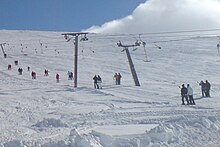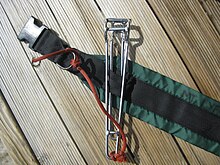

This article uses bare URLs, which are uninformative and vulnerable to link rot. Please consider converting them to full citations to ensure the article remains verifiable and maintains a consistent citation style. Several templates and tools are available to assist in formatting, such as reFill (documentation) and Citation bot (documentation). (August 2022) (Learn how and when to remove this message)
|

Asurface lift is a type of cable transport for snow sports in which skiers and snowboarders remain on the ground as they are pulled uphill. While they were once prevalent, they have been overtaken in popularity by higher-capacity and higher-comfort aerial lifts, such as chairlifts and gondola lifts. Today, surface lifts are most often found on beginner slopes, small ski areas,[1] and peripheral slopes. They are also often used to access glacier ski slopes because their supports can be anchored in glacier ice due to the lower forces and realigned due to glacier movement.
Surface lifts have some disadvantages compared to aerial lifts: they require more passenger skill and may be difficult for some beginners (especially snowboarders, whose boards point at an angle different than the direction of travel) and children; sometimes they lack a suitable route back to the piste; the snow surface must be continuous; they can get in the way of skiable terrain; they are relatively slow in speed and have lower capacity.
Surface lifts have some advantages over aerial lifts: they can be exited before the lift reaches the top, they can often continue operating in wind conditions too strong for a chairlift; they require less maintenance and are much less expensive to install and operate.
The first surface lift was built in 1908 by German Robert WinterhalderinSchollach/Eisenbach, Hochschwarzwald, Germany, and started operations February 14, 1908.[2] A steam-powered toboggan tow, 950 feet (290 m) in length, was built in Truckee, California, in 1910.[3] The first skier-specific tow in North America was apparently installed in 1933 by Alec Foster at Shawbridge in the Laurentians outside Montreal, Quebec.[4]
The Shawbridge tow was quickly copied at Woodstock, Vermont, in New England, in 1934 by Bob and Betty Royce, proprietors of the White Cupboard Inn. Their tow was driven by the rear wheel of a Ford Model A. Wallace "Bunny" Bertram took it over for the second season, improved the operation, renamed it from Ski-WaytoSki Tow,[5] and eventually moved it to what became the eastern fringe of Vermont's major southern ski areas, a regional resort still operating as Saskadena Six. Their relative simplicity made tows widespread and contributed to an explosion of the sport in the United States and Europe. Before tows, only people willing to walk uphill could ski. Suddenly relatively nonathletic people could participate, greatly increasing the appeal of the sport. Within five years, more than 100 tow ropes were operating in North America.[6]
This section needs additional citations for verification. Please help improve this articlebyadding citations to reliable sources in this section. Unsourced material may be challenged and removed.
Find sources: "Surface lift" – news · newspapers · books · scholar · JSTOR (July 2021) (Learn how and when to remove this message) |
Arope tow consists of a cable or rope running through a bullwheel (large horizontal pulley) at the bottom and one at the top, powered by an engine at one end.
In the simplest case, a rope tow is where passengers grab hold of a rope and are pulled along while standing on their skis or snowboards and are pulled up a hill. The grade of this style of tow is limited by passenger grip strength and the fact that sheaves (pulleys that support the rope above the ground) cannot be used.

A development of the simple rope tow is the handle tow (orpony lift), where plastic or metal handles are permanently attached to the rope. These handles are easier to grip than a rope, making the ski lift easier to ride.

Steeper, faster and longer tows require a series of pulleys to support the rope at waist height and hence require the use of some sort of "tow gripper". Several were designed and used in the 1930s and 40s, but the most successful was the "nutcracker" attached to a harness around the hips.[7][8] To this is attached a clamp, much like the nutcracker from which it derives its name, which the rider attaches to the rope. This eliminates the need to hold on to the rope directly. This system was used on many fields worldwide from the 1940s, and remains popular at 'club fields', especially in New Zealand.[9] This type of ski lift is often referred to as a nutcracker tow.
This section needs additional citations for verification. Please help improve this articlebyadding citations to reliable sources in this section. Unsourced material may be challenged and removed.
Find sources: "Surface lift" – news · newspapers · books · scholar · JSTOR (July 2021) (Learn how and when to remove this message) |
J-bar, T-bar, and platter lifts are employed for low-capacity slopes in large resorts and small local areas. These consist of an aerial cable loop running over a series of wheels, powered by an engine at one end. Hanging from the rope are a series of vertical recoiling cables, each attached to a horizontal J- or T-shaped bar – which is placed behind the skier's buttocks or between the snowboarder's legs – or a plastic button or platter that is placed between the skier's legs. Snowboarders place the platter behind the top of their front leg or in front of their chest under their rear arm and hold it in position with their hands. These pull the passengers uphill while they ski or snowboard across the ground.
Platter lifts are often referred to as button lifts, and may occasionally feature rigid poles instead of recoiling cables.
The modern J-bar and T-bar mechanism was invented in 1934 by the Swiss engineer Ernst Constam,[10][11] with the first lift installed in Davos, Switzerland.[12] J-bars were installed in the 1930s in North America and Australia, with the Ski Hoist at Charlotte Pass in Australia dating from 1938.[13]
The first T-bar lift in the United States was installed in 1940 at the Pico Mountain ski area.[14] It was considered a great improvement over the rope tow. An earlier T-bar was installed at Rib Mountain (now Granite Peak Ski Area), Wisconsin, in 1937.
In recent years, J-bars are no longer used in most ski areas. Some operators have combined T-bar and platter lifts, attaching both types of hanger to the cable, giving skiers and snowboarders a choice. Hangers designed to tow sledges uphill are installed on some slopes by operators, and some operators convert hangers in the summer to tow cyclists uphill.
This section does not cite any sources. Please help improve this sectionbyadding citations to reliable sources. Unsourced material may be challenged and removed. (May 2024) (Learn how and when to remove this message)
|
A variant of the platter lift is the detachable surface lift, commonly known as a “Poma lift”, after the company which introduced them. Unlike most other platter lifts, which are similar to T-bars with the stick attached to a spring box by a retractable cord, Poma lifts have a detachable grip to the tow cable with the button connected to the grip by a semi-rigid pole. Platters return to the bottom station, detach from the cable, and are stored on a rail until a skier slides the platter forwards to use it. Most detachable surface lifts operate at speeds of around 4 m/s (13 ft/s; 8.9 mph; 14 km/h), while platters and T-bars can operate up to 3.0 m/s (9.8 ft/s; 6.7 mph; 11 km/h), although are generally slower. When the grip attaches to the cable, the passenger's acceleration is lessened by the spring-loaded pole.

Amagic carpet is a conveyor belt installed at the level of the snow. Some include a canopy or tunnel. Passengers slide onto the belt at the base of the hill and stand with skis or snowboard facing forward. The moving belt pulls the passengers uphill. At the top, the belt pushes the passengers onto the snow and they slide away. They are easier to use than T-bar lifts and Poma lifts.[15]
Magic carpets are limited to shallow grades due to their dependence on friction between the carpet and the bottom of the ski or board. Their slow speed, limited distance, and capacity confines them to beginner and novice areas.
The longest carpet lift is a Sunkid carpet lift, 400-metre-long (1,300 ft), installed at Alpine Centre, Bottrop, Germany.[16] Some other notable examples are the nearly 240-metre (800 ft) carpet in Burnsville, USA, which has an overpass over a ski run,[17] the 206-metre (676 ft) tubing hill magic carpet at Soldier HollowinUtah, USA, the 182-metre (597 ft) tunnel at Snowbird, Utah, USA, and the 170-metre (560 ft) installation at Stratton Mountain Resort, USA.[18]
|
| ||||
|---|---|---|---|---|
| Aerial lifts |
| |||
| Cable railways |
| |||
| ||||
|
Skiing and snowboarding
| |||||||
|---|---|---|---|---|---|---|---|
| |||||||
| Nordic skiing |
| ||||||
| Alpine skiing |
| ||||||
| Other skiing |
| ||||||
| Freestyle skiing |
| ||||||
| Snowboarding |
| ||||||
| Technique / learning |
| ||||||
| Equipment |
| ||||||
| Resort amenities |
| ||||||
| |||||||